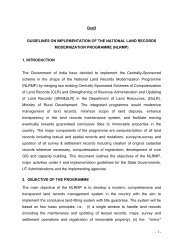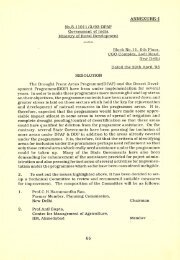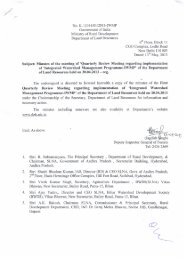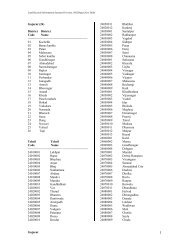Uttarakhand - Department of Land Resources
Uttarakhand - Department of Land Resources
Uttarakhand - Department of Land Resources
Create successful ePaper yourself
Turn your PDF publications into a flip-book with our unique Google optimized e-Paper software.
the agricultural sector. Pr<strong>of</strong>essional and costly moneylenders were the only source <strong>of</strong><br />
credit to agriculture till 1935.<br />
With the passing <strong>of</strong> Reserve Bank <strong>of</strong> India Act 1934, District Central Co-op. Banks Act<br />
and <strong>Land</strong> Development Banks Act, agricultural credit received impetus. A powerful<br />
alternative credit distribution system agency came into being. Large-scale credit became<br />
available with reasonable rates <strong>of</strong> interest at easy terms, both in terms <strong>of</strong> granting loans<br />
and recovery. Both the Co-operative and Nationalized banks advanced credit mostly to<br />
agriculture. The former advanced short-term and medium term loans while the latter<br />
advanced long-term loans. The Reserve Bank <strong>of</strong> India as the Central bank <strong>of</strong> the<br />
country took lead in making credit available to agriculture through these banks by laying<br />
down suitable policies.<br />
Although the co-operative banks started financing agriculture with their establishments<br />
in 1930‟s, significant growth happened only after Independence when suitable legislation<br />
was passed and policies were formulated. Thereafter, bank credit to agriculture made<br />
phenomenal progress by opening branches in rural areas and attracting deposits.<br />
Fourteen major commercial banks were nationalized in 1969, co-operative banks were<br />
the main institutional agencies providing finance to agriculture. After nationalization, it<br />
was made mandatory for these banks to provide finance to agriculture as a priority<br />
sector. These banks undertook special programs <strong>of</strong> branch expansion and created a<br />
network <strong>of</strong> banking services throughout the country and started financing agriculture on<br />
large scale. Thus agriculture credit acquired a multi-agency dimension.<br />
The procedures and amount <strong>of</strong> loans for various purposes have been standardized.<br />
Among the various purposes "Crop loans" (Short-term loan) has the major share. In<br />
addition, farmers get loans for purchase <strong>of</strong> electric motor with pump, tractor and other<br />
machinery, digging wells or boring wells, installation <strong>of</strong> pipe lines, drip irrigation, planting<br />
fruit orchards, purchase <strong>of</strong> dairy animals and feeds/fodder for them, poultry, sheep/goat<br />
keeping and for many other allied enterprises.<br />
Banks across the country are however increasingly waking up the potential <strong>of</strong><br />
agricultural credit, having realized that barring natural calamities and climatic vagaries,<br />
the Indian farmer is a reliable borrower. They have also realized that a more local and<br />
81
















